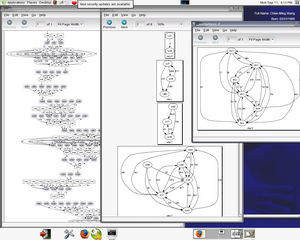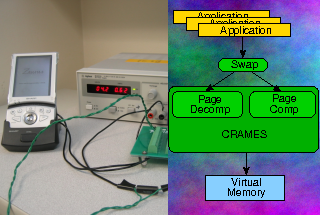Projects and publicly available tools
We often make these websites after work is mature, so please see the publications page for recent work.
 |
A dataset of footage from a fixed camera looking at a traffic intersection. The three videos constitute approximately one hour of footage and offer differing lighting and weather conditions.
This dataset is intended to provide a source of long-form fixed-camera footage for testing embedded computer vision techniques. To this end, individual frames and machine-generated object detection annotations are provided.
Dataset prepared by Benjamin Simpson and Yuchen Liu. Original videos obtained from Digital Vision Security with permission. Distribution and use for research purposes is allowed. |
 |
This National Science Foundation project on Reliability Driven Resource Management of Multi-Core Real-Time Embedded Systems focused on developing algorithms and analysis techniques to improve reliability in real-time systems subject to both permanent faults resulting from temperature-dependent wear processes and transient faults resulting from strikes by high-energy subatomic particles. This project developed techniques to measure the wear progression in microprocessors using only software; algorithms to improve the reliability of embedded systems containing heterogeneous compute cores and graphics processing units; and analysis techniques for estimating fault probabilities in integrated circuits subject to a variety of lifetime wear processes and transient faults, including spatially heterogeneous faults resulting from within-package high-energy particle emission. |
Firmware
for the M-Pod wearable air quality sensing node.
Author: Yun Xiang.
 |
PowerTutor is on-line smartphone power estimation software. It uses
smartphone component power management and activity state introspection to
estimate the power consumption of each component, and determine the energy use
of software applications.
Authors: Mark Gordon, Birjodh Tiwana, Lide Zhang, Robert Dick, Zhuoqing
Morley Mao, and Lei Yang. |
The Sonar Power
Manager uses ultrasound produced by your computer's speakers and measured
by your computer's microphone to determine whether you are nearby. It can
assist in power management. BatPhone identifies the user's
location based on audio environment.
Authors: Stephen P. Tarzia, Robert P. Dick, Peter A. Dinda, Gokhan Memik.
 |
CETA is a fully-automated tool for extracting run-time communication
graphs from multithreaded applications.
Authors: Ai-Hsin Liu and Robert P. Dick with additional documentation by
Ciprian Radu. |
 |
MEMMU is an automated runtime memory compression technique for MMU-less
embedded systems. It provides application developers with access to more usable
RAM and requires no or minor changes to application code and no changes to
hardware. MEMMU is composed of a runtime library and LLVM passes for
compile-time transformation.
Authors: Lan Bai, Lei Yang, and Robert P. Dick. |
 |
CRAMES is an operating system controlled memory compression technique to
double usable memory in embedded systems without changing applications or
hardware, and with little or no performance or power penalty.
Authors: Lei Yang, Robert P. Dick, Haris Lekatsas, and Srimat
Chakradhar. |

|
ISAC is adaptive steady-state and dynamic thermal analysis software.
Authors: Nicholas Allec, Xi Chen, Zyad Hassan, Yonghong Yang, Zhenyu Gu,
Changyun Zhu, Li Shang, and Robert P. Dick. |
| Embedded system synthesis software |
This software, described in the MOGAC, CORDS, COWLS, and MOCSYN papers
(above) has been licensed to PDV Software of Allentown, Pennsylvania.
However, I can provide academic access to interested parties on my group
server. If you would like to use this synthesis software, please send me an
email describing the intended use.
Author: Robert P. Dick |
 The Embedded Systems Synthesis Benchmarks Suite is a
collection of benchmarks based on embedded processor and task
information from the Embedded Microprocessor Benchmark Consortium
(EEMBC). E3S was developed for
use in system-level allocation, assignment, and scheduling research.
The current version, 0.9, contains contains 17 processors, e.g., the
AMD ElanSC520, Analog Devices 21065L, the Motorola MPC555, and the
Texas Instruments TMS320C6203. These processors are characterized
based on the measured execution times of 47 tasks, power numbers
derived from processor datasheets, and additional information, e.g.,
die sizes, some of which were necessarily estimated, and prices
gathered by emailing and calling numerous processor vendors. In
addition, E3S contains communication resources modeling a number of
different busses, e.g., CAN, IEEE1394, PCI, USB 2.0, and VME.
The Embedded Systems Synthesis Benchmarks Suite is a
collection of benchmarks based on embedded processor and task
information from the Embedded Microprocessor Benchmark Consortium
(EEMBC). E3S was developed for
use in system-level allocation, assignment, and scheduling research.
The current version, 0.9, contains contains 17 processors, e.g., the
AMD ElanSC520, Analog Devices 21065L, the Motorola MPC555, and the
Texas Instruments TMS320C6203. These processors are characterized
based on the measured execution times of 47 tasks, power numbers
derived from processor datasheets, and additional information, e.g.,
die sizes, some of which were necessarily estimated, and prices
gathered by emailing and calling numerous processor vendors. In
addition, E3S contains communication resources modeling a number of
different busses, e.g., CAN, IEEE1394, PCI, USB 2.0, and VME.
Author: Robert P. Dick
 creates problem instances for use in allocation and scheduling
research. It has the ability to generate independent tasks as well
as task sets which are composed of partially ordered task graphs. A
complete description of a scheduling problem instance is created,
including attributes for processors, communication resources, tasks,
and inter-task communication.
creates problem instances for use in allocation and scheduling
research. It has the ability to generate independent tasks as well
as task sets which are composed of partially ordered task graphs. A
complete description of a scheduling problem instance is created,
including attributes for processors, communication resources, tasks,
and inter-task communication.
Authors: Keith Vallerio, David
Rhodes, and Robert P. Dick.
Python
modules for graph algorithms, class delegation, and logic
minimization.
Authors: Robert P. Dick and Kosta Gaitanis.
MPSoC reliability modeling software described in this publication. Allows estimate of system-level reliability in the presence of various lifetime wear processes in MPSoCs supporting task reassignment on core failure.
Authors: Yun Xiang, Robert P. Dick, and Thidapat Chantem.
Page maintained by Robert
Dick.






